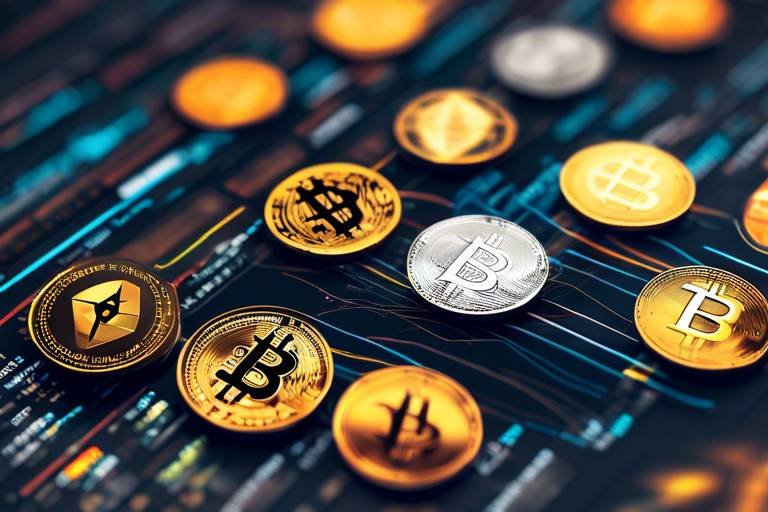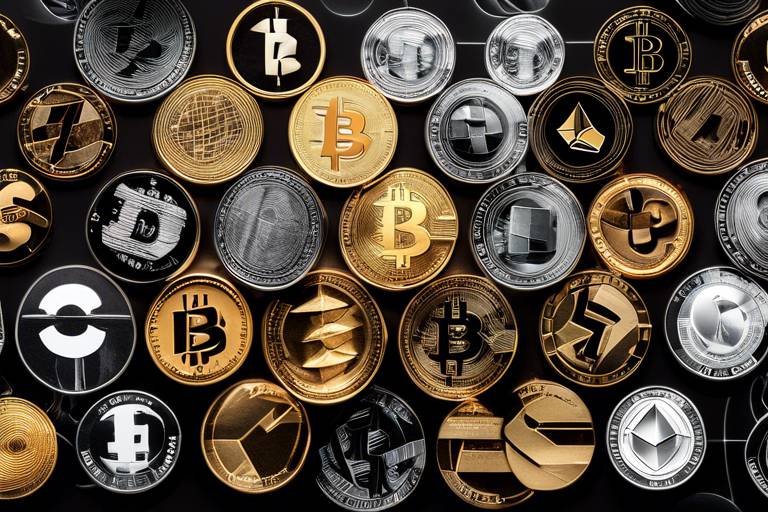Market Analysis - The Effect of Economic Stimulus on Crypto
The world of cryptocurrency is often seen as a wild west of investment opportunities, where fortunes can be made or lost in the blink of an eye. But what happens when the government steps in with economic stimulus measures? This article explores how these measures can significantly influence the cryptocurrency markets, examining trends, investor behavior, and potential future impacts on the crypto landscape. Buckle up as we dive into the intricate dance between economic stimuli and crypto dynamics!
Economic stimulus refers to a series of government actions aimed at promoting economic activity, especially during downturns. These actions can take various forms, including direct financial assistance to individuals, tax cuts, and increased government spending on infrastructure projects. The primary goal is to boost consumer spending and restore confidence in the economy. In recent history, we've seen numerous examples of economic stimulus, particularly in response to global events such as the 2008 financial crisis and the COVID-19 pandemic. Each of these measures has left a lasting imprint on both traditional and digital markets.
Economic stimulus often sends ripples through traditional financial markets, influencing stock prices, interest rates, and overall investor sentiment. For instance, when governments announce stimulus packages, stock markets typically react positively, as investors anticipate increased consumer spending and corporate profits. However, this can also lead to inflated asset prices, creating a bubble that may eventually burst. Understanding these trends is crucial for crypto investors, as the behavior of traditional markets can set the stage for shifts in crypto investment. As the saying goes, "When the tide rises, all boats float." Thus, a booming stock market may also lift cryptocurrencies, albeit sometimes unpredictably.
When examining the relationship between crypto markets and economic stimulus, it's essential to analyze historical data to identify patterns and correlations. For instance, during significant stimulus announcements, we often see a surge in crypto prices as investors seek alternative assets to hedge against inflation and currency devaluation. A recent study indicated that during the stimulus checks distributed in 2020, many individuals turned to cryptocurrencies like Bitcoin and Ethereum, driving their prices to new heights. This correlation suggests that economic stimulus can act as a catalyst for crypto adoption, especially among retail investors looking for quick returns.
Understanding how investors react during economic stimulus measures is crucial for predicting market movements. Behavioral finance plays a significant role here. When stimulus checks hit bank accounts, many investors display an increased risk appetite, often driven by the fear of missing out (FOMO). This can lead to a surge in speculative investments in cryptocurrencies. However, it's important to note that such behavior can also result in irrational decision-making, where investors chase trends without proper research. As the saying goes, "In a bull market, everyone is a genius," but the reality is that the market can turn quickly, leaving those who didn't do their homework in a precarious position.
To better understand the impact of economic stimulus on crypto prices, let's look at a few notable case studies. For instance, following the announcement of the $2 trillion stimulus package in March 2020, Bitcoin experienced a dramatic price increase, climbing from around $5,000 to over $60,000 in the following months. This surge can be attributed to increased buying pressure from both retail and institutional investors, who viewed Bitcoin as a safe haven against inflation. Another example is the Federal Reserve's decision to lower interest rates during the pandemic, which led to a spike in crypto investments as traditional savings accounts offered minimal returns. These case studies illustrate how intertwined the fate of cryptocurrencies can be with economic stimulus measures.
As we look toward the future, the ongoing and potential economic stimulus measures will likely continue to shape the crypto landscape. Experts predict that as governments seek to stabilize their economies, we may see a more structured approach to stimulus measures, which could include digital currencies. This might lead to increased legitimacy for cryptocurrencies as a viable investment option. However, investors should remain cautious and consider that while stimulus can boost the market, it can also lead to increased regulation and scrutiny, which could impact crypto prices in the long run.
Investing during periods of economic stimulus is not without its risks. Market volatility can spike, leading to sudden price swings that can catch even seasoned investors off guard. Additionally, there's a danger of over-relying on government intervention to prop up markets. As the old adage goes, "What goes up must come down," and this is especially true for assets that have been artificially inflated by external factors. Investors should approach stimulus-driven investments with a balanced perspective, weighing the potential for gains against the risks of sudden downturns.
Regulations play a crucial role in shaping the crypto landscape, and economic stimulus measures can influence regulatory actions. For instance, as governments increase their spending and consider digital currencies as part of their financial systems, we may see stricter regulations imposed on cryptocurrencies to ensure stability and consumer protection. This could have significant implications for cryptocurrency investors and businesses, as navigating a more regulated environment may require adjustments in strategy and compliance. Staying informed about these changes will be essential for anyone looking to thrive in the crypto market.
In conclusion, navigating the crypto market during periods of economic stimulus requires careful analysis and a keen understanding of market dynamics. By recognizing the correlations between government actions and investor behavior, and staying aware of potential risks and regulatory changes, investors can position themselves to capitalize on unique market conditions. Remember, in the world of crypto, knowledge is power, and being informed is the best strategy to ride the waves of economic change!
- What is economic stimulus? Economic stimulus refers to government measures aimed at boosting economic activity, especially during downturns.
- How does economic stimulus affect cryptocurrency prices? Economic stimulus can lead to increased investor interest in cryptocurrencies, often resulting in price surges.
- Are there risks associated with investing in crypto during stimulus periods? Yes, market volatility and over-reliance on government intervention are significant risks to consider.
- What role do regulations play in the crypto market? Regulations can shape the crypto landscape, influencing how cryptocurrencies are traded and invested in.

Understanding Economic Stimulus
Economic stimulus is a term that often pops up in discussions about financial markets, especially during times of economic downturn. But what does it really mean? In simple terms, economic stimulus refers to a variety of government actions aimed at boosting economic activity. These measures are designed to stimulate spending, increase employment, and ultimately revive a sluggish economy. Think of it as a shot of adrenaline for the economy, intended to jumpstart growth when it seems to be stalling.
Governments employ several methods to implement economic stimulus, including fiscal policy and monetary policy. Fiscal policy involves changes in government spending and taxation, while monetary policy typically includes adjustments to interest rates and the money supply by central banks. For instance, during a recession, a government might decide to cut taxes to leave more money in the pockets of consumers, or it might increase public spending on infrastructure projects to create jobs. On the other hand, a central bank might lower interest rates to make borrowing cheaper, encouraging businesses and consumers to spend more.
To give you a clearer picture, here’s a quick look at the different types of economic stimulus measures:
- Direct Payments: Cash payments to individuals, often seen in stimulus checks.
- Tax Cuts: Reductions in taxes aimed at increasing disposable income.
- Infrastructure Spending: Government investment in public projects to create jobs and stimulate growth.
- Low-Interest Rates: Central banks lowering rates to encourage borrowing and spending.
The effectiveness of these measures can vary significantly depending on various factors, including the overall economic environment and the specific challenges being faced. For example, during the COVID-19 pandemic, many governments around the world enacted unprecedented stimulus packages to counteract the economic fallout. These packages included a mix of direct payments to citizens, enhanced unemployment benefits, and substantial funding for businesses. The goal was clear: to prevent a complete economic collapse and to ensure that when the crisis passed, economies could rebound swiftly.
However, while economic stimulus can provide a short-term boost, it is essential to consider the long-term implications. Over-reliance on government intervention can lead to issues such as inflation, increased national debt, and market distortions. Investors should be aware of these potential pitfalls as they navigate the complexities of the financial landscape during stimulus periods. Understanding the nuances of economic stimulus is crucial for anyone looking to make informed investment decisions, especially in the volatile world of cryptocurrency.

Impact on Traditional Markets
The world of finance is a complex web, and at its core lies the relationship between traditional markets and economic stimulus measures. When governments decide to pump money into the economy, they are not just throwing cash around; they are igniting a chain reaction that can ripple through various financial sectors. But how exactly does this impact traditional markets? Well, let's break it down.
First off, economic stimulus often leads to a surge in stock prices. Think of it as a booster shot for the economy. When interest rates are lowered and more money is available, investors feel more confident. They start buying stocks, which drives prices up. This phenomenon is not just a theory; it's a pattern we've observed repeatedly. For instance, during the 2008 financial crisis, the U.S. government implemented several stimulus packages, leading to a significant rebound in stock prices over the following years.
Moreover, the impact of stimulus measures extends beyond just the stock market. Interest rates play a pivotal role as well. When central banks lower rates, borrowing becomes cheaper for both consumers and businesses. As a result, spending increases, which can lead to higher demand for goods and services. This increased demand can boost corporate earnings, further propelling stock prices upward. In essence, lower interest rates create a favorable environment for investments, enticing investors to pour money into traditional markets.
But it’s not just about the numbers; it's also about sentiment. Economic stimulus can drastically shift investor sentiment. When people see the government taking action to support the economy, they often feel more secure about their financial futures. This newfound optimism can lead to increased investment activity, which in turn fuels further growth in traditional markets. It’s a cycle of confidence that can lead to significant market movements.
To illustrate the impact of economic stimulus on traditional markets, let’s look at a simplified table summarizing key effects:
| Effect | Description |
|---|---|
| Stock Price Surge | Increased buying activity leads to higher stock prices. |
| Lower Interest Rates | Cheaper borrowing costs stimulate consumer and business spending. |
| Positive Investor Sentiment | Government action fosters confidence in the economy, encouraging investment. |
However, it’s crucial to remember that these effects are not always linear. The relationship between economic stimulus and traditional markets can be influenced by various external factors, such as geopolitical events, changes in consumer behavior, and even technological advancements. For example, during the COVID-19 pandemic, initial stimulus measures caused a sharp rise in stock prices, but subsequent waves of the virus and lockdowns led to increased volatility and uncertainty in the markets.
In conclusion, the impact of economic stimulus on traditional markets is significant and multi-faceted. It not only affects stock prices and interest rates but also shapes investor sentiment. As we navigate through these economic waters, understanding these dynamics can provide valuable insights for investors looking to make informed decisions in both traditional and emerging markets, such as cryptocurrency.

Correlation Between Crypto and Economic Stimulus
The relationship between cryptocurrency markets and economic stimulus measures is a fascinating one, often resembling a dance where each partner influences the other's movements. When governments implement stimulus packages, they aim to inject liquidity into the economy, encouraging spending and investment. This influx of capital can have profound effects on various asset classes, including cryptocurrencies. But how exactly does this correlation manifest?
Historically, we have seen that during periods of significant economic stimulus, there tends to be a noticeable uptick in interest and investment in cryptocurrencies. For instance, when central banks lower interest rates or introduce quantitative easing, traditional investors often seek alternative assets to hedge against inflation and currency devaluation. This is where cryptocurrencies, particularly Bitcoin, come into play as a digital gold alternative.
To illustrate this correlation, let’s take a look at some key events in recent history. The COVID-19 pandemic prompted unprecedented stimulus measures worldwide. In the United States, the Federal Reserve slashed interest rates to near-zero levels and rolled out massive economic relief packages. As a result, the crypto market saw a significant surge, with Bitcoin reaching all-time highs. The influx of cash into the economy led many investors to turn to crypto, driving prices up and increasing market participation.
| Year | Stimulus Measure | Bitcoin Price Movement |
|---|---|---|
| 2020 | COVID-19 Relief Packages | Increased from $7,000 to over $60,000 |
| 2008 | TARP and Quantitative Easing | Bitcoin launched, starting at $0.08 |
| 2021 | Continued Economic Stimulus | Fluctuated between $30,000 and $64,000 |
Moreover, the psychological aspect of investing plays a crucial role in this correlation. When investors see government action aimed at stabilizing the economy, it often breeds confidence. This newfound optimism can lead to increased risk-taking behavior, with many turning to cryptocurrencies as a high-risk, high-reward investment. The allure of potential profits in a rapidly changing market can be intoxicating, prompting both seasoned investors and newcomers alike to dive into the crypto space.
However, it's essential to note that this relationship is not always straightforward. While stimulus measures can drive prices up, they can also lead to volatility. As investors react to changing economic conditions, the crypto market can experience sharp fluctuations. This unpredictability can create a rollercoaster effect, where prices soar one moment and plummet the next, leaving investors grappling with uncertainty.
In summary, the correlation between economic stimulus and cryptocurrency markets is an intricate interplay of financial strategies, investor psychology, and market dynamics. As we continue to navigate an ever-evolving economic landscape, understanding this relationship will be crucial for investors looking to capitalize on opportunities that arise during stimulus periods.
- How does economic stimulus affect cryptocurrency prices?
Economic stimulus can lead to increased liquidity and investor confidence, often resulting in higher cryptocurrency prices as more investors seek alternative assets.
- Are there risks associated with investing in crypto during stimulus periods?
Yes, while there may be opportunities for profit, the crypto market can be highly volatile during these times, leading to potential losses.
- What historical events illustrate the correlation between crypto and economic stimulus?
Significant events include the COVID-19 relief measures in 2020 and the financial crisis of 2008, both of which saw notable impacts on cryptocurrency markets.

Investor Behavior During Stimulus Periods
Understanding how investors react during economic stimulus periods is crucial for anyone looking to navigate the often-turbulent waters of financial markets. When governments inject money into the economy, it can create a ripple effect that influences investor behavior in significant ways. Think of it as a sudden splash in a pond; the initial drop creates waves that can shift the direction of everything around it.
During these stimulus phases, we often see a marked change in risk appetite. Investors who might typically shy away from volatile assets suddenly find themselves more willing to dive into the crypto market. Why is that? It's simple: the influx of cash into the economy often leads to a sense of optimism. With interest rates low and cash readily available, many investors feel emboldened to take risks they might otherwise avoid. This phenomenon can be likened to a group of friends at a party—once one person starts dancing, others are likely to join in, creating a lively atmosphere that encourages even more participation.
Moreover, the psychology of investor behavior plays a significant role during these periods. Behavioral finance suggests that emotions often drive decisions more than cold, hard facts. When governments announce stimulus packages, it can create a buzz of excitement and hope, leading to increased buying activity in the crypto markets. This can result in rapid price increases, as seen in various historical instances.
However, it's not all sunshine and rainbows. The euphoria can quickly turn to panic if market conditions change. Investors may rush to sell their assets at the first sign of trouble, leading to sharp market corrections. This kind of volatility can be disorienting, akin to a rollercoaster ride—thrilling at first, but potentially stomach-churning as the ride takes unexpected turns.
To illustrate this point further, let's consider some statistics from past stimulus periods. A
| Year | Stimulus Package | Crypto Price Change (%) |
|---|---|---|
| 2020 | COVID-19 Relief | +200% |
| 2008 | Financial Crisis Bailout | +150% |
| 2021 | American Rescue Plan | +300% |
In summary, investor behavior during economic stimulus periods is characterized by increased risk-taking and heightened emotional responses. While this can lead to significant gains, it also poses risks that investors must navigate carefully. The key is to remain informed and aware of the underlying market dynamics, ensuring that decisions are based on sound analysis rather than fleeting emotions.
As we look toward the future, it’s essential for investors to consider both the opportunities and risks that come with stimulus-driven environments. Balancing optimism with caution can help in making informed investment choices that stand the test of time.

Case Studies: Stimulus and Crypto Prices
When it comes to understanding the intricate dynamics of cryptocurrency prices during periods of economic stimulus, looking at historical case studies can provide invaluable insights. One of the most striking examples occurred in 2020 during the COVID-19 pandemic. As governments around the world rolled out unprecedented fiscal measures aimed at revitalizing their economies, the cryptocurrency market experienced a significant surge. The U.S. government, for instance, introduced stimulus checks and increased unemployment benefits, injecting trillions of dollars into the economy. This influx of capital not only bolstered traditional markets but also created a ripple effect in the crypto space.
The initial response from investors was one of optimism. With traditional assets like stocks and bonds facing uncertainty, many turned to cryptocurrencies as a hedge against inflation and economic instability. Bitcoin, often referred to as "digital gold," saw its price soar from around $7,000 in March 2020 to over $60,000 by April 2021. This meteoric rise can be attributed to several factors:
- Increased liquidity: The influx of government stimulus checks provided individuals with disposable income, which many chose to invest in cryptocurrencies.
- Institutional interest: Major companies and institutional investors began to view cryptocurrencies as a legitimate asset class, further driving demand.
- Fear of inflation: As governments printed money, fears of inflation grew, prompting investors to seek alternative stores of value.
Another noteworthy case study occurred in Japan following the 2016 economic stimulus measures. The Bank of Japan implemented a negative interest rate policy, which aimed to encourage spending and investment. As a result, many Japanese citizens began exploring cryptocurrencies as an alternative investment option. The price of Bitcoin in Japan surged, reflecting a growing trend among investors looking to escape traditional financial systems. This scenario illustrates how economic policies can directly influence investor behavior and crypto prices.
To further illustrate the impact of stimulus measures on crypto prices, let's look at the following table that summarizes key events and their effects on Bitcoin's price:
| Date | Event | Bitcoin Price (Approx.) |
|---|---|---|
| March 2020 | COVID-19 Stimulus Announcement | $7,000 |
| December 2020 | Institutional Adoption Surge | $20,000 |
| April 2021 | Record High Amid Continued Stimulus | $60,000 |
| January 2021 | Launch of Bitcoin Futures ETFs | $40,000 |
These case studies highlight a clear pattern: economic stimulus measures tend to create an environment where cryptocurrencies thrive. However, while the initial response is often positive, the long-term effects can vary. Investors must remain vigilant, as the crypto market is notoriously volatile and can shift rapidly based on external factors, including regulatory changes and market sentiment.
In conclusion, analyzing past instances where economic stimulus impacted cryptocurrency prices reveals a complex relationship. As more data becomes available, investors can better understand these trends and make informed decisions. The key takeaway is that while economic stimulus can provide a significant boost to crypto prices, the market's inherent volatility means that caution is always warranted.
Q: How does economic stimulus affect cryptocurrency prices?
A: Economic stimulus often leads to increased liquidity in the market, encouraging investment in cryptocurrencies as alternatives to traditional assets.
Q: Are there risks associated with investing in crypto during stimulus periods?
A: Yes, while stimulus can drive prices up, it can also lead to increased volatility and potential market corrections.
Q: Can historical case studies predict future trends in crypto?
A: Historical trends can provide insights, but the crypto market is highly unpredictable, and past performance does not guarantee future results.

Future Predictions for Crypto Markets
The future of cryptocurrency markets is a topic that generates both excitement and skepticism. As we stand on the cusp of potential economic transformations driven by ongoing stimulus measures, investors are left wondering: what lies ahead for their digital assets? To navigate this dynamic landscape, we must consider various factors that could shape the future of crypto markets.
First and foremost, the adoption of blockchain technology is likely to accelerate. As traditional financial institutions continue to explore the integration of cryptocurrencies into their services, we can expect a surge in mainstream acceptance. This could lead to increased demand for cryptocurrencies, pushing prices higher. Imagine a world where buying coffee with Bitcoin is as common as swiping a credit card—this is not just a dream, but a potential reality!
Another key factor to consider is the regulatory environment. As governments worldwide grapple with how to handle cryptocurrencies, the regulations they implement could either foster growth or stifle innovation. For instance, if regulations are clear and supportive, we may see institutional investors flocking to crypto, much like moths to a flame. Conversely, stringent regulations could lead to market volatility, as investors react to perceived threats to their investments.
Moreover, the influence of macroeconomic factors cannot be ignored. The ongoing economic stimulus measures, such as those seen during the COVID-19 pandemic, have already demonstrated a correlation with crypto price movements. If governments continue to inject liquidity into the economy, it could further fuel speculative investments in cryptocurrencies, driving prices to new heights. However, this could also lead to a bubble, where prices rise unsustainably before crashing down.
To illustrate these points, let's look at a hypothetical scenario where economic stimulus measures remain robust:
| Year | Predicted Bitcoin Price | Market Sentiment |
|---|---|---|
| 2024 | $100,000 | Optimistic |
| 2025 | $150,000 | Speculative |
| 2026 | $50,000 | Pessimistic |
In this table, we can see a potential trajectory for Bitcoin prices based on optimistic and speculative market sentiment. However, it’s important to note that these predictions are based on assumptions that may not hold true in reality. The crypto market is notoriously unpredictable—like trying to catch smoke with your bare hands!
Lastly, we cannot overlook the role of technological advancements in shaping the future of crypto. Innovations such as decentralized finance (DeFi) and non-fungible tokens (NFTs) are already changing the way we think about assets and investments. As these technologies mature, they could open new avenues for investment and create opportunities that we can’t yet imagine. The future is bright, but it’s also fraught with uncertainty.
In conclusion, while the future of crypto markets appears promising, it is essential for investors to remain vigilant and informed. By understanding the interplay between economic stimulus, regulatory changes, and technological advancements, investors can position themselves to take advantage of the opportunities that lie ahead. So, are you ready to dive into the future of crypto?
- What impact does economic stimulus have on cryptocurrency prices?
Economic stimulus can lead to increased liquidity in the market, potentially driving up cryptocurrency prices as more investors enter the space. - How can I prepare for future changes in the crypto market?
Staying informed about market trends, regulatory changes, and technological advancements can help you make better investment decisions. - Are cryptocurrencies a good long-term investment?
While cryptocurrencies can be volatile, many investors believe they have long-term potential due to increasing adoption and innovation.

Risks Associated with Stimulus-Driven Investments
When it comes to investing during periods of economic stimulus, it's essential to tread carefully. While these measures can create a fertile ground for growth, they also come with a unique set of risks that investors must navigate. One of the most significant dangers is market volatility. Economic stimulus often leads to rapid price fluctuations, particularly in the cryptocurrency market, which is already known for its inherent instability. This volatility can catch even seasoned investors off guard, leading to impulsive decisions that may not align with their long-term strategies.
Another critical risk is the over-reliance on government intervention. Stimulus measures can create a false sense of security among investors, leading them to believe that the government will always step in to support the economy. This mindset can result in a lack of due diligence when evaluating investments. For instance, if an investor assumes that a cryptocurrency will continue to rise simply because of ongoing stimulus, they may overlook fundamental weaknesses or market signals that suggest otherwise.
Furthermore, the relationship between traditional financial markets and cryptocurrencies can create additional layers of risk. For example, if stimulus measures lift stock prices but have minimal impact on crypto, investors may find themselves in a precarious position. The disconnect between these markets can lead to confusion and misinformed investment decisions. To illustrate this, consider the following table that outlines the potential impacts of economic stimulus on different asset classes:
| Asset Class | Potential Impact | Risk Level |
|---|---|---|
| Stocks | Increased prices due to liquidity | Moderate |
| Bonds | Lower yields, higher prices | Low |
| Cryptocurrencies | High volatility, unpredictable trends | High |
Additionally, behavioral biases can play a significant role in how investors react to stimulus-driven market conditions. During these times, many investors may exhibit herd behavior, following the crowd rather than conducting thorough research. This can lead to inflated asset prices and eventual market corrections, causing substantial losses for those who entered the market late. Recognizing these biases is crucial for making informed investment decisions.
In summary, while economic stimulus can create opportunities in the cryptocurrency market, it is vital for investors to remain vigilant and informed. Understanding the risks associated with these investments can help mitigate potential pitfalls. By conducting thorough research, maintaining a diversified portfolio, and being aware of market dynamics, investors can better navigate the complexities of the crypto landscape during stimulus periods.
- What are the main risks of investing in cryptocurrencies during economic stimulus? The main risks include market volatility, over-reliance on government intervention, and behavioral biases that can lead to poor investment decisions.
- How can I mitigate risks when investing in crypto during stimulus periods? Diversifying your portfolio, conducting thorough research, and staying informed about market trends can help mitigate risks.
- Is it wise to invest in cryptocurrencies when the government is implementing economic stimulus? It can be wise, but investors should be cautious and aware of the unique risks that come with such investments.

Regulatory Considerations
The world of cryptocurrency is a thrilling rollercoaster ride, isn't it? With the rapid rise and fall of digital currencies, it's crucial to understand the regulatory landscape that governs these assets. Regulatory considerations can significantly impact how cryptocurrencies are perceived and traded. As governments worldwide grapple with the implications of digital currencies, the rules surrounding them evolve, often at a dizzying pace.
One of the primary concerns for regulators is consumer protection. With the crypto market being notorious for its volatility, authorities are keen on ensuring that investors are not left high and dry. This has led to the implementation of various regulations aimed at safeguarding consumers from fraud and market manipulation. For instance, many countries have established guidelines for initial coin offerings (ICOs) to prevent misleading claims and ensure transparency.
Moreover, the question of taxation looms large over cryptocurrency transactions. Different jurisdictions have adopted varying stances on how digital currencies should be taxed, leading to confusion among investors. Some countries treat cryptocurrencies as property, while others classify them as currency. This inconsistency creates a patchwork of regulations that can be daunting for investors trying to navigate their tax obligations. Understanding these regulations is not just a matter of compliance; it can also significantly affect profitability and investment strategies.
Another critical aspect of regulatory considerations is the potential for government intervention. Economic stimulus measures can influence regulatory actions, as governments may feel pressured to act swiftly in response to market fluctuations. For instance, during periods of significant economic stimulus, we might see more stringent regulations being proposed to curb excessive speculation in the crypto markets. This creates a delicate balance between encouraging innovation in the blockchain space and ensuring market stability.
Furthermore, the rise of decentralized finance (DeFi) platforms has complicated the regulatory landscape even further. These platforms operate without traditional intermediaries, making it challenging for regulators to enforce existing laws. As DeFi continues to grow, we may witness a push for new regulatory frameworks that specifically address the unique challenges posed by these technologies.
In light of these complexities, it's essential for investors to stay informed about regulatory developments. Monitoring changes in legislation can provide valuable insights into future market trends and help investors make more informed decisions. After all, being proactive rather than reactive can be the difference between riding the wave of opportunity and getting swept away by unforeseen challenges.
In summary, regulatory considerations play a pivotal role in shaping the future of the cryptocurrency market. As the landscape continues to evolve, investors must remain vigilant and adaptable to navigate these changes effectively.
- What are the main regulatory challenges facing cryptocurrencies? Regulatory challenges include consumer protection, taxation, and the need for clear guidelines on ICOs and DeFi platforms.
- How do regulations affect cryptocurrency prices? Regulatory news can lead to significant price fluctuations as investors react to potential changes in the market landscape.
- Are all cryptocurrencies regulated equally? No, regulations vary by country and can differ significantly in terms of how they classify and treat different cryptocurrencies.
- What should investors do to stay compliant with regulations? Investors should regularly consult legal experts, follow news on regulatory changes, and ensure they understand their tax obligations related to cryptocurrency transactions.

Conclusion: Navigating the Crypto Landscape
As we wrap up our exploration of the intricate relationship between economic stimulus and the cryptocurrency market, it's essential to recognize that navigating this landscape requires a blend of caution and insight. The insights gleaned from our analysis reveal that economic stimulus measures can significantly influence investor behavior and market dynamics. In times of economic uncertainty, when traditional markets may falter, cryptocurrencies often emerge as a beacon of hope for many investors seeking alternative avenues for growth.
However, it's crucial to approach these opportunities with a well-informed mindset. The correlation between economic stimulus and crypto prices is not always straightforward; while past trends may suggest a bullish outlook, market volatility remains a constant companion in the world of digital currencies. Investors are encouraged to stay vigilant, continuously educating themselves about market trends, historical patterns, and potential regulatory changes that could impact their investments.
Moreover, understanding the psychology of investors during stimulus periods can provide valuable insights into market movements. As we have discussed, behavioral finance plays a significant role in shaping investment strategies, with risk appetite often fluctuating based on external economic factors. Therefore, creating a balanced investment portfolio that considers both traditional assets and cryptocurrencies can be a prudent strategy.
In conclusion, while the allure of quick gains in the crypto market can be tempting, it is vital to remember the inherent risks associated with such investments. A well-rounded approach that combines research, risk management, and a keen awareness of the broader economic landscape will serve investors well in their quest to capitalize on the opportunities presented by economic stimulus measures. As always, staying informed and adaptable will be key to thriving in this ever-evolving market.
- What is economic stimulus? Economic stimulus refers to government initiatives aimed at promoting economic growth, often through fiscal measures like increased spending or tax cuts.
- How does economic stimulus affect the crypto market? Economic stimulus can lead to increased liquidity and investor interest in cryptocurrencies, as traditional markets may face uncertainty.
- Are there specific historical events that highlight the impact of stimulus on crypto prices? Yes, several events, such as the COVID-19 stimulus packages, have shown significant correlations between stimulus measures and rising crypto prices.
- What risks should I consider when investing in crypto during stimulus periods? Key risks include market volatility, the potential for over-reliance on government support, and regulatory changes that could affect the crypto landscape.
- How can I stay informed about the crypto market? Regularly follow reputable financial news sources, engage with crypto communities, and consider using analytical tools to track market trends.
Frequently Asked Questions
- What is economic stimulus and how does it impact the economy?
Economic stimulus refers to government actions aimed at boosting economic activity, especially during downturns. It can take various forms, such as tax cuts, increased government spending, or monetary policy adjustments. These measures are designed to encourage spending and investment, which in turn can lead to economic growth.
- How does economic stimulus affect traditional financial markets?
Economic stimulus often leads to increased liquidity in the market, which can boost stock prices and investor sentiment. Lower interest rates typically result from stimulus measures, making borrowing cheaper and encouraging businesses to invest. This can create a ripple effect, influencing the crypto market as investors seek higher returns.
- Is there a correlation between economic stimulus and cryptocurrency prices?
Yes, there is often a correlation between economic stimulus measures and cryptocurrency prices. Historical data shows that stimulus announcements can lead to significant price movements in crypto markets, as investors react to the increased liquidity and potential for higher returns. Understanding these patterns can help inform investment strategies.
- How do investors behave during periods of economic stimulus?
During economic stimulus periods, investors tend to exhibit increased risk appetite. They may shift their investment strategies, moving funds into higher-risk assets like cryptocurrencies in search of greater returns. This behavioral shift can lead to increased volatility in crypto markets as more investors enter the space.
- Can you provide examples of case studies where stimulus affected crypto prices?
Absolutely! One notable case is the response of Bitcoin prices following the 2020 U.S. stimulus package. After the announcement, Bitcoin saw a significant price surge as investors flocked to crypto, viewing it as a hedge against inflation and currency devaluation. Analyzing such case studies helps identify trends and potential future behavior in the market.
- What are the potential risks of investing during economic stimulus periods?
Investing during economic stimulus phases carries several risks, including heightened market volatility and the possibility of over-reliance on government intervention. If investors become too dependent on stimulus measures, they may face significant losses when those measures are withdrawn or adjusted, leading to market corrections.
- How do regulations impact the cryptocurrency market in the context of economic stimulus?
Regulatory considerations are crucial as they can shape the crypto landscape significantly. Economic stimulus may prompt governments to revisit or implement new regulations, affecting how cryptocurrencies are traded and used. Investors should stay informed about regulatory changes to navigate the market effectively.
- What should investors consider when navigating the crypto landscape during economic stimulus?
Investors should conduct thorough research and analysis to understand market trends and potential risks. Staying updated on economic indicators and government policies can provide valuable insights. Additionally, diversifying investments and being prepared for market volatility can help mitigate risks associated with stimulus-driven environments.



















